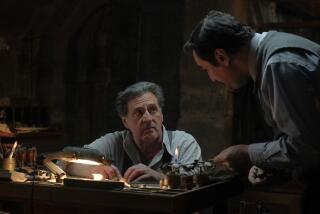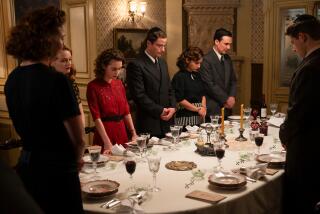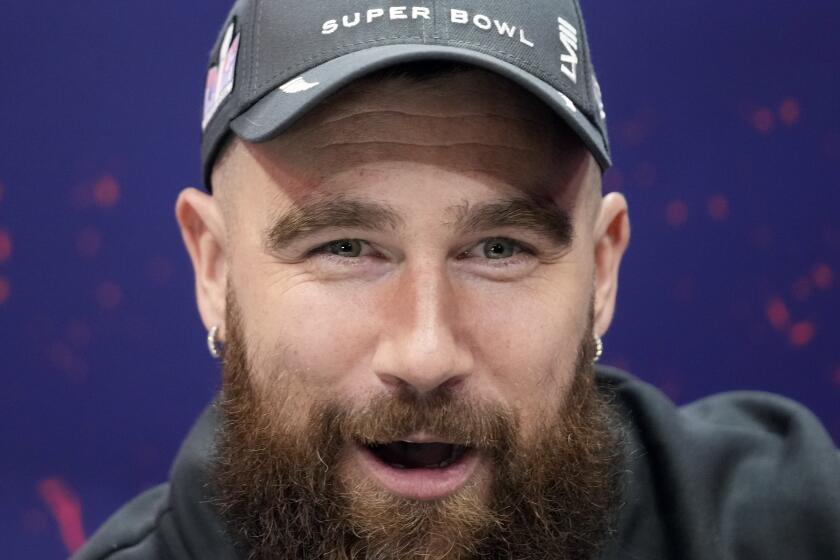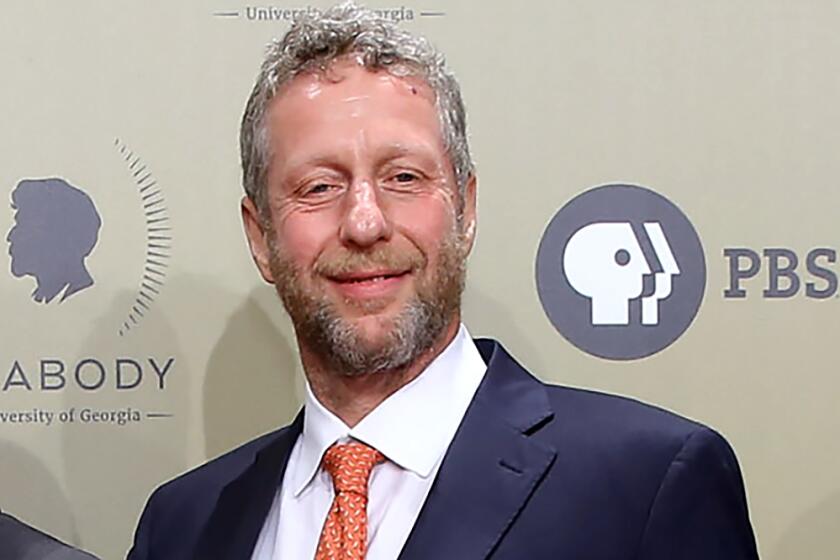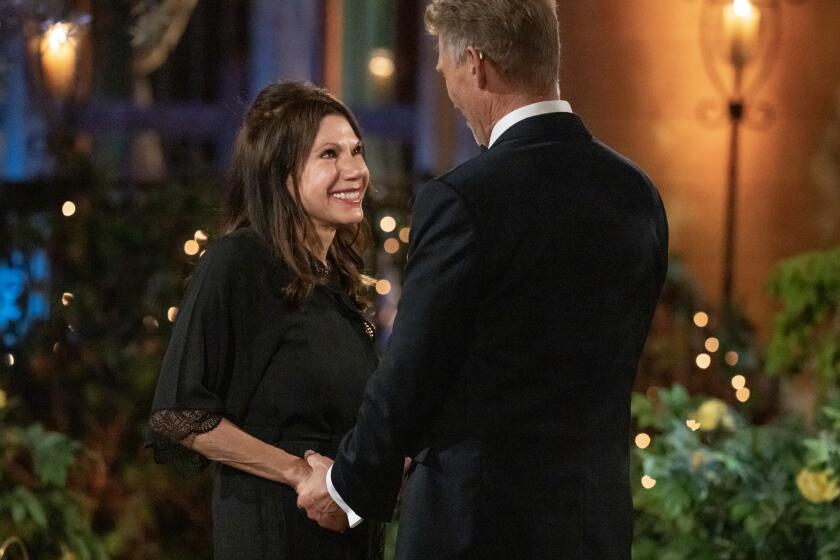‘Mythical Creatures’: Gary Baseman’s search in ‘Holocaust by Bullets’ sites
When his father passed away in 2010 at the age of 93, artist Gary Baseman says he went through a very dark period.
“I didn’t cut my hair for, like, nine months,” he recalls. “And my art, which has always been pretty playful and provocative, it got really dark. It hit me like a ton of bricks.”
It also filled him with a sense of urgency. “When my father passed away, the burden of needing to tell his story became really great,” Baseman says. “I felt like if I didn’t tell his story it would be lost.”
And it is indeed a remarkable story, one that will serve as a basis for an imaginative and unusual film that Baseman and a team of collaborators are currently working on.
The artist’s father, Ben Baseman, was born into a Jewish family in Berezne, a small settlement on the Sluch River that over its history has been both Russian and Polish. (It is currently part of Ukraine.) At the start of World War II, however, it was firmly in Poland. When the Germans arrived, they rounded up the town’s more than 3,600 Jews, forced them to dig mass graves and proceeded to shoot them all. Among the murdered were Ben’s parents (Gary’s grandparents). Some historians refer to this episode as the “Holocaust by Bullets.”
In the chaos, however, Ben Baseman managed to escape to a nearby forest, where he joined a group of Soviet partisans. He spent the rest of the war camped in the woods, fighting the German army.
“My father was probably in his mid-20s when all of this happened,” the artist says. “He always told me never to go back to his hometown — not even to think about it. When he left, he said everything was destroyed.”
But despite what his father had always told him, Baseman decided to go back. In 2012, he found himself in Latvia, teaching art on a Fulbright Specialist Grant. And he decided to make the journey to Berezne, to lay eyes on the place that his father was from, and where his grandparents were buried, somewhere in an unmarked mass grave.
While he was in Ukraine, he also went to visit Kostopol, his mother’s hometown. His mother’s family had suffered a similar fate as the elder Basemans during the war. Her parents had sent her to Lviv to wait out the invasion. She survived; they did not. She met Ben Baseman at a relocation camp in Lviv after the war. (The family moved to Los Angeles in 1958; the future artist was born in L.A. in 1960 and grew up in the Fairfax District.)
With his father’s admonition ever present, it was difficult for Baseman to go back and see the places that had caused his family so much pain.
“I’m not the kind of person who cries a lot,” he says. “But I was breaking down every day. I was thinking that maybe my dad was right. I thought, ‘Maybe I can’t handle it. Maybe I shouldn’t have opened this Pandora’s box.’ But as emotional as it was, it was very important for me to do this.”
He spent the journey taking pictures, making sketches and shooting short interviews with people he met along the way.
“I was able to talk to a woman who witnessed the massacre of the town’s Jews in Kostopol,” Baseman says. “It was such an intense experience.”
That journey inspired him to get serious about telling his family’s tale. Last summer, he included their furniture in an installation at the Skirball Cultural Center called “The Door Is Always Open.” Late last year, he created a birch forest installation at the Shulamit Gallery in Venice that paid visual tribute to the years his father had spent as a partisan. He also created an animated video inspired by these stories for the Museum of Contemporary Art’s YouTube channel, MOCAtv, in collaboration with animator Peter Markowski, musical duo Die Antwoord and director David Charles. (Note: the video contains strong language.)
All of this has led to the biggest project yet: “Mythical Creatures,” a full-length feature film that will also be directed by Charles.
Like all things Baseman, this will not be a straightforward doc. Baseman is a prolific artist and illustrator whose work has appeared in Time, the New York Times and the New Yorker as well as the L.A. Times. In 2004, he created an animated children’s series, “Teacher’s Pet,” which was later turned into a movie by Disney. His drippy, monster-laden paintings and installations have been shown from Edinburgh to Taipei.
Baseman says the film will be a hybrid: combining live-action documentary elements, along with extensive animated sequences, and other story-telling techniques.
“There will be paintings and drawings and all of it will be used as a way of understanding my father and mother,” he explains. “It’s going to be a combination of things.
“It’s really about taking all of the different narratives from the myths I’ve been told and mixing them with my character to try and find my truth,” he says. “We’re not doing it in a straightforward historical way. It’s really an exploration of my psyche.”
The film has the support of the Sundance Institute’s New Frontier Story Lab and the Museum of the Holocaust in Los Angeles. This past summer, the artist launched a successful Kickstarter campaign for additional financing. He hoped to raise $75,000. He managed to pull in more than $100,000.
“It’s pretty incredible,” says Baseman. “It’s the Kickstarter money that is giving us the funding to go to the Ukraine to film.”
This Sunday, Baseman and Charles will depart for Eastern Europe for close to a month to document Baseman’s family history, along with the history of World War II battlegrounds like Berezne and Kostopol, along with whatever they may encounter along the way. Baseman says they have a shot list, but they are also open to improvisation.
“I’m really just going with a big open heart and eyes,” he says. “My goal is to also work with some Ukrainian artists to create an art installation in my parents’ hometowns.”
Baseman says that he is ready for whatever comes his way.
“I grew up in L.A. surrounded by Holocaust survivors,” he explains. “The people down the street, the family members who were around, friends from Eastern Europe. But they didn’t want us to be too overwhelmed by it. They commiserated among themselves but they didn’t really share all the details with us kids. The idea is that we would have this fresh start. We would be the all-Americans living in Hollywood and Disney.
“But I think this needs to be told to a new generation,” he adds. “I want to be able to tell their story in a new way.”
Find me on Twitter @cmonstah. Plus, you can find Gary Baseman @garybaseman.
More to Read
The biggest entertainment stories
Get our big stories about Hollywood, film, television, music, arts, culture and more right in your inbox as soon as they publish.
You may occasionally receive promotional content from the Los Angeles Times.
